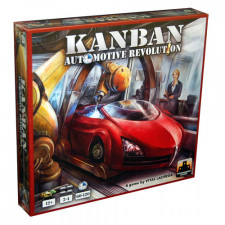Kanban: Automotive Revolution Review
on Oct 22, 2015
Processes. If Vital Lacerda loves one thing, it’s processes. In Vinhos, it was wine production. In CO2 it was energy companies. The Gallerist is about running art galleries. While I enjoy all of these games, I am particularly fond of Kanban, a game about the automobile assembly process. At the end of the day, Kanban is just another worker placement game, but it’s a worker placement game that expresses its themes and setting quite well.
Each player takes on the role of a department manager in a car factory. These middle-managers are trying to impress the big boss lady, Sandra. There are five departments: Testing and Innovation, Assembly Line, Logistics, Design, and Administration. There’s a Recycling area that allows you to swap out parts and Human Resources tracks your efficiency. Kanban uses a delayed action placement mechanic; you place your guys then you active them once everyone is ready to work. The game happens over a set number rounds. The game ends when one of two things happen: the Production Cycle marker is on the third space and the Week marker is on the second space or the Week marker is on the third space and the Production Cycle is on the third.
Each of the five departments has two available “shifts†– places to assign your worker. The shifts allow for different amounts of “work†to be done in a given department. The leftmost space in a department allows you to go first – picking the parts you want, producing the car of your choice, etc., but you can only do two actions, or a couple of hours’ worth of work, in the department. The rightmost spot lets you perform three actions, but you have to wait and lament the presence of the suck up who got there first. After your worker works, he lies down and takes a little nap until it’s time to start a new work day. Working in a factory is exhausting.
Actions activate from left to right, and Sandra moves from left to right. Players can never stay in the department in which they just performed work, and Sandra will always move to the first available spot in the next department to the right. After the work day ends, new shifts are chosen based on the location of the workers from left to right. For players, this means you might be locked out a department before you have an opportunity to choose it. For Sandra, this means she might be locked out of a department before she has a chance to assess its effectiveness. This is good if you don’t want her to clear an area before you have are able to perform the action you want, but it’s bad because it shortens the work week, meaning you effectively have one less turn.
Needless to say, turns are incredibly important for your departmental efficiency. The Testing & Innovation Department lets you improve car parts and earn rewards for doing so. Cars are produced on the Assembly Line but can’t have duplicate parts, limiting your ability to access certain cars. Logistics allows you to acquire the needed parts for your car and gives you extra banked time for working in the warehouse. You choose the next hot car or the next innovative technology in the Design Department. By working in a department, you are manipulating its ability to produce products efficiently. What might be good for you may totally destroy your opponent’s plans and vice versa.
If your plans were foiled, you can work towards a department’s certification instead. Becoming certified allows players to unlock spaces on their player board and in the Administration Department. Players who choose to overachieve and become an expert through Advanced Training will be awarded the benefit of their choice along with a seat in the weekly meeting. Human Resources also takes note of employees who earn their certification and rewards them justly; the most certified person has the added benefit of being the first to speak during meetings.
The end of the work week happens when Sandra returns her desk, which is located in the Administration Department. At the end of the week, players are rewarded for testing upgraded designs. To score points at the end of the week, you need two things: cars in your garage and upgrades. For each car you have that has upgrades, you score points. If you upgraded the parts for a car in your garage, you score two points; if someone else upgraded parts for a car in your garage, you score one point. Different model cars carry different values based on the difficulty of their production. Black cars may be worth a lot of points, but green cars are cheaper and easier to make. Basically, you can be Ferrari, or you can be Chevy. The choice is yours.
A meeting will only happen if Sandra returns to her desk and the big white meeting cube is present. The Administration Department determines performance goals for players to work toward between meetings. During a meeting, players use seats in their color (not red ones) to vote toward the performance goals and offer a “pet project†from their hand. Ideally, no one else should be able to join in on your pet project, but they probably will, and you’ll hate them for it. And, because no one likes a show off, you can only meet a performance goal once. When the meeting is over, you will suggest a performance goal for the next meeting.
As Kanban implies, efficiency is rewarded (or punished depending on which which mood Sandra is in). Sandra is fickle beast, and she can be nice, or she can be mean. Nice Sandra rewards the players who meet certain criteria; Mean Sandra punishes those who don’t. I recommend playing with mean Sandra, especially if you’re sadistic.
I’ve never worked in a car factory, but I imagine it feels a lot like playing Kanban. There’s a lot to get done and limited time in which to do it. The man, or woman in this case, is always looking over your back reciting efficiency quotes ad nauseam. You’re constantly trying to come up with the next big idea only to have it rejected in a board meeting. It’s not easy, but it’s rewarding; and, that’s how it feels to play Kanban. Yes, there are a lot of rules. Yes, it’s easy to miss something. As you play though, you find a groove that is often lacking in heavier games. While the feeling of satisfaction you get from outperforming your opponents is amazing, the beautiful thing about Kanban is that it uses theme to streamline an incredibly euro-y game.

 Customer Support
Customer Support  Subscribe
Subscribe 




 Account
Account  Wishlist
Wishlist 

